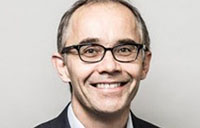The process of seeing is a lot more complicated than it looks. A roster of leading biological and computer vision researchers will discuss the latest research on how humans and machines integrate and organize visual cues, June 23 to 26, at York University.
The stellar line up of invited international speakers will showcase their work at the York University Centre for Vision Research International Conference on Perceptual Organization. The themes for the conference will include object boundaries and shape, light and shading, visual scenes and motion, and more.

The conference is organized by York University Professor James Elder, who received $1.65 million last month from the Natural Sciences and Engineering Research Council of Canada, to lead a six-year research program in data analytics and visualization.
Among the topics that will be featured:
- York University Professor Laurence Harris will address the role of the body in perceptual organization;
- Rutgers University Professor Steve Silverstein will discuss impairments to perceptual organization in schizophrenia and resulting clues to the neurobiology underlying this disease;
- Bielefeld University Professor Marc Ernst will explore common mechanisms of perceptual organization in vision and our sense of touch.
- University of Toronto Professor Dirk Bernhardt-Walther will assess 2D cues to 3D structure in real-world scenes;
- Massachusetts Institute of Technology Professor Bill Freeman will detail his team’s recent development of a “motion microscope” that magnifies tiny motions, such as the breathing of a premature baby; and
- University of Southampton Professor Wendy Adams will speak on how we use our sense of vision and touch to determine whether an object is shiny.
The International Conference on Perceptual Organization will take place in 109 Accolade West Building (June 24 & 25); and 206 Accolade West Building (June 26) on York University’s Keele campus.
The conference is supported by Magstim and the following faculties, departments and offices at York University: Office of the Vice President Research and Innovation, Lassonde School of Engineering, Faculty of Health, Faculty of Science, Department of Psychology, Department of Electrical Engineering and Computer Science, and the School of Kinesiology and Health Science.
For more information and to view the full program schedule, visit the conference website.


